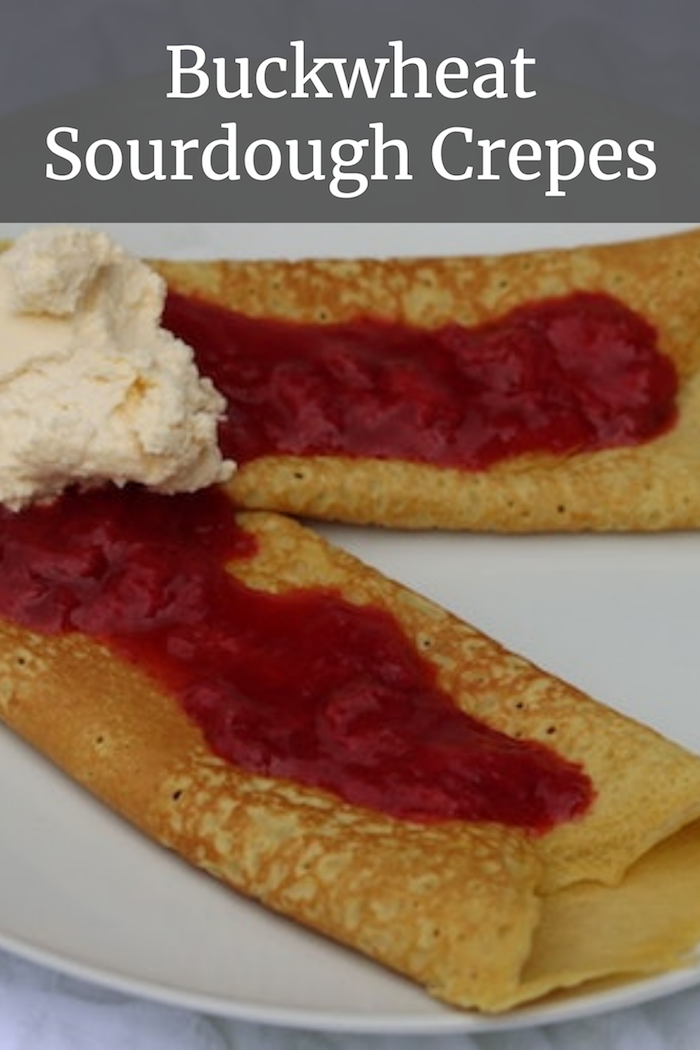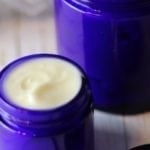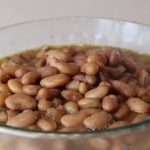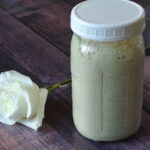These Buckwheat Sourdough Crepes are a breakfast staple in our house! Despite what you may think, crepes are just as easy to make as pancakes. These crepes are gluten-free, loaded with healthy fats and protein. A much better way to start your day than the toxic cereal that most of the country starts their day with!! Let’s take a closer look at a few of the nutrient-dense ingredients.
Buckwheat Sourdough starter:
- is high in magnesium! Magnesium helps with calcium absorption, which helps with bone health, heart health, a good night sleep, as well as many other things. Unfortunately, between soil depletion and poor diets, most of us are deficient in magnesium. Here is a link learn how to make your own magnesium roll-on to apply to your feet before bed.)
- is a good source of potassium, iron, and B vitamins.
- has more protein than any of the grains traditionally consumed in the SAD (Standard American Diet), such as wheat, rice, or corn.
- contains the essential amino acids lysine and arginine. Lysine benefits your gut, your brain, as well as coldsores or other herpetic lesions. Arginine supports the kidneys and bladder, as well as helps alleviate congestive heart failure.
- contains a fair amount of resistant starch (Source). Resistant starch (aka prebiotics) feeds the “good bacteria” in your microbiome but doesn’t feed the “bad bugs” hanging out in there. Getting resistant starch is as important, if not more important, as getting probiotics!
My post “How to Make and Maintain a Buckwheat Sourdough Starter” will give you the step by step of how to make your own. I also have a recipe for Buckwheat Sourdough Pancakes and Waffles, one for Buckwheat Sourdough Pumpkin Bread, and Buckwheat Sourdough Sugar Cookies. Look for a sandwich bread recipe coming soon. (fingers crossed!)
Grass-fed Milk or a Milk Substitute:
If you can’t tolerate dairy, you can use hemp milk, almond, milk or coconut milk instead.
If you can tolerate dairy, you can’t beat raw grass-fed whole milk’s nutrition profile!. Raw milk is not pasteurized and it is not homogenized. This makes it so much healthier for you than store-bought.
- Pasteurizing reduces vitamins as well as kills off beneficial enzymes that your body needs to help digest the milk! Many people who believe they are lactose intolerant have no trouble digesting milk once they switch to raw dairy.
- When milk is homogenized, the fat particles are spun around very quickly until they become very small. They become something unrecognizable to your body. It is a similar problem to those of trans-fats, also known as hydrogenated fats. We have all heard by now about the dangers of hydrogenated fats (although they are still hidden in many processed and prepared foods, so read labels!) If you don’t have a choice to buy raw milk in your area, choose an organic, grass-fed non-homogenized version.
- When a cow eats the food it was meant to eat (mainly grass), you get all the health benefits of the grass without having to eat the grass yourself. When cows eat grain or corn, especially non-organic grain or corn that is GMO and heavily sprayed with pesticides, you get the drawbacks, of that diet. It is also worth tugging at your heart strings a bit by mentioning that the quality of life of a grass-fed dairy cow is much preferable to that of a poor, conventional dairy cow.
Pastured eggs:
- Omega 3’s (Important for brain and mood health)
- Vitamin E (An Anti-oxidant that helps repair cellular damage.)
- Vitamin D (Important for immunity and mood)
- Vitamin K2 (Hard to get in your diet unless you eat liver or leafy greens)
- Choline (Crucial to cognitive function)
Grass-fed gelatin:
- Protects your joints: Have knee pain? Tennis elbow? Ankles that pop? Start adding grass-fed gelatin and collagen to your diet. Gelatin also helps with arthritis pain.
- Improves digestion and seals the gut lining: Gelatin can prevent and help heal “leaky gut”. It also can reduce or eliminate bloating, acid reflux, nutrient deficiencies, and anemia. Grass-fed gelatin can reduce constipation and water retention as well.
- Can help you get a restful night’s sleep: When taken at bedtime, gelatin can improve the quality of your sleep, shorten the time it takes you to fall asleep, and help you feel more rested throughout the day.
- Improve the appearance and health of your skin: As we age, we start to produce less collagen. This causes wrinkles and sagging skin. Taking gelatin and/or collagen can prevent and even reverse skin damage with cellular regeneration.
- Helps maintain strong bones: Gelatin is full of the nutrients necessary to maintain bone health.
- Can make you feel fuller longer: This can translate to less snacking which is tough on the digestion and impedes weight loss.
- Is good for your heart: Our society loves to eat muscle meat! We generally go for the chicken breasts, filet mignon, and pork tenderloins. By doing this, we miss out on many beneficial amino acids that are contained in the cartilage, bones, and organs of the animals. While eating tip to tail is ideal, we can use grass-fed gelatin and collagen to fill in those gaps when we haven’t been doing so.
- Can boost your mood and brain power: Because gelatin contains glycine, an “inhibitory neurotransmitter”, it lowers stress hormones while increasing hormones like GABA which make us happy.
Fine sea salt:
- Contains important trace minerals that are missing in table salt.
Grass-fed Butter:
- Vitamin K2 (This is hard to get in your diet unless you eat liver or leafy greens)
- Butyrate (An anti-inflammatory fatty acid)
- Omega 3’s (Brain and mood health)
- Vitamin A (Good for eyes and teeth)
- Vitamin E (anti-oxidant)
- Conjugated Linoleic Acid (Immune booster)
Tools:
Carbon steel crepe pan: While making crepes in a teflon or other chemically coated non-stick pan might be easy, it is also toxic. I love my carbon steel crepe pan. Not only is it non-toxic, it is non-stick once it is seasoned! I also love using silicon spatulas because they don’t contain any of the harmful chemicals in plastic spatulas. They are also nice and thin so they are easy to slide under your crepe or tortilla to flip. Don’t use metal spatulas with this pan (or any non-stick pan) because it can scratch your pan.

Buckwheat Sourdough Crepes:
- 1 cup buckwheat sourdough starter
- 4 pastured eggs
- 1/2 cup grass-fed milk
- 2 Tablespoons butter, melted
- 1 T grass-fed gelatin
- 1 t vanilla
- 1/4 teaspoon fine sea salt
Directions:
- Put milk in a heat proof glass bowl or a sauce pan and sprinkle gelatin over the top. Allow gelatin to bloom for a few minutes and then warm the mixture up. I use a pyrex in my toaster oven (350 for 5-8 minutes), but you can warm it on the stove as well. You want the gelatin to fully dissolve.
- Melt 2 T grass-fed butter. I do this in my toaster oven as well. I do it at the same time as a milk but in a separate heat-proof cup. About 3 minutes if softened, and 5 minutes if cold.
- In another bowl, combine the starter, eggs, vanilla, and salt.
- Heat a crepe pan or skillet over medium heat (I don’t use my power burner for this. I use the next largest burner).
- Add a small amount of butter to grease the pan if you are not using a seasoned crepe pan.
- Ladle out about 2 – 3 ounces on to the center of the pan, pick up the pan and tilt and turn it so that batter spreads in a circular motion.
- Cook for about 1-2 minutes. The edges will come away from the pan slightly when it is ready to flip.
- Flip and cook for one minute.
- Move to a plate and repeat with remaining batter. Give the batter a good stir with the ladle each time before scooping as GF flours tend to separate from liquid. If you are not using a seasoned crepe pan, you will need to add a small amount of butter each time so that your crepes don’t stick.
- Top crepes with berries, berry sauce, whipped cream, maple butter, or butter and syrup.
- You can also eliminate the vanilla and use these as sandwich wraps!
Buckwheat Sourdough Crepes
Ingredients
- 1 cup buckwheat sourdough starter
- 4 pastured eggs
- 1/2 cup grass-fed milk
- 1 T grass-fed gelatin
- 1 t vanilla
- 1/4 teaspoon fine sea salt
Instructions
- Put milk in a heat proof glass bowl or a sauce pan and sprinkle gelatin over the top. Allow gelatin to bloom for a few minutes and then warm the mixture up. I use a pyrex in my toaster oven (350 for 5-8 minutes), but you can warm it on the stove as well. You want the gelatin to fully dissolve.
- Melt 2 T grass-fed butter. I do this in my toaster oven as well. I do it at the same time as a milk but in a separate heat-proof cup. About 3 minutes if softened, and 5 minutes if cold.
- In another bowl, combine the starter, eggs, vanilla, and salt.
- Heat a crepe pan or skillet over medium heat (I don't use my power burner for this. I use the next largest burner).
- Add a small amount of butter to grease the pan if you are not using a seasoned crepe pan.
- Ladle out about 2 - 3 ounces on to the center of the pan, pick up the pan and tilt and turn it so that batter spreads in a circular motion.
- Cook for about 1-2 minutes. The edges will come away from the pan slightly when it is ready to flip.
- Flip and cook for one minute.
- Move to a plate and repeat with remaining batter. Give the batter a good stir with the ladle each time before scooping as GF flours tend to separate from liquid. If you are not using a seasoned crepe pan, you will need to add a small amount of butter each time so that your crepes don't stick.
- Top crepes with berries, berry sauce, whipped cream, maple butter, or butter and syrup.




















